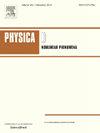双分量Novikov方程的多峰系统
IF 2.7
3区 数学
Q1 MATHEMATICS, APPLIED
引用次数: 0
摘要
Novikov方程是Camassa-Holm方程的一个迷人的可积修正,具有显著的性质。研究了一类具有非自伴随4 × 4 Lax算子的双分量Novikov方程。我们探讨了相关的正、逆谱图,以及关于峰扇区的全局存在性和长期渐近性。一方面,我们使用moser启发技术对长时间状态执行等谱变形以计算相关特征值。为了实现这一点,我们首先证明了峰值流的全局存在性,然后建立了位置和动量的长时间渐近性与非零特征值之间的联系。我们引入了三个Weyl函数,并表明它们是离散正测度的矩阵值Stieltjes变换,再次采用变形技术。这有效地线性化了频谱数据侧的峰值流。相反,我们使用涉及张量积和附加对称条件的hermite - pad本文章由计算机程序翻译,如有差异,请以英文原文为准。
On the multipeakon system of a two-component Novikov equation
The Novikov equation is a fascinating integrable modification of the Camassa–Holm equation with remarkable properties. This paper concentrates on a two-component Novikov equation featuring a non-self-adjoint 4 × 4 Lax operator. We explore the associated forward and inverse spectral maps, as well as global existence and long-time asymptotics concerning the peakon sector. On one hand, we execute an isospectral deformation to the long-time regime to compute the relevant eigenvalues using a Moser-inspired technique. To achieve this, we first demonstrate the global existence of the peakon flows, then establish a connection between the long-time asymptotics of positions and momenta and the non-zero eigenvalues. We introduce a trio of Weyl functions and show that they are matrix-valued Stieltjes transforms of discrete positive measures, again employing the deformation technique. This effectively linearizes the peakon flows on the spectral data side. Conversely, we tackle the inverse problem using Hermite–Padé approximation techniques that involve tensor products and an added symmetry condition. The thorough analysis guarantees existence and uniqueness, yielding global multipeakon formulas.
求助全文
通过发布文献求助,成功后即可免费获取论文全文。
去求助
来源期刊

Physica D: Nonlinear Phenomena
物理-物理:数学物理
CiteScore
7.30
自引率
7.50%
发文量
213
审稿时长
65 days
期刊介绍:
Physica D (Nonlinear Phenomena) publishes research and review articles reporting on experimental and theoretical works, techniques and ideas that advance the understanding of nonlinear phenomena. Topics encompass wave motion in physical, chemical and biological systems; physical or biological phenomena governed by nonlinear field equations, including hydrodynamics and turbulence; pattern formation and cooperative phenomena; instability, bifurcations, chaos, and space-time disorder; integrable/Hamiltonian systems; asymptotic analysis and, more generally, mathematical methods for nonlinear systems.
 求助内容:
求助内容: 应助结果提醒方式:
应助结果提醒方式:


